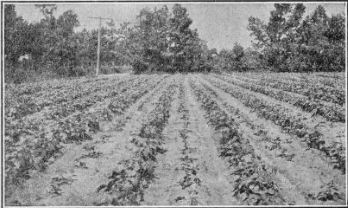Bean (Vicia, Phaseolus). Part 3
Description
This section is from the book "Vegetable Gardening", by Ralph L. Watts. Also available from Amazon: Vegetable Gardening.
Bean (Vicia, Phaseolus). Part 3
Notwithstanding these facts, beans exhibit great differences in their power to withstand heat and cold. The seeds of some decay more quickly than others when the soil is cool and moist. Some are more tender to frost than others. All vary greatly in the length of time required to reach maturity. Hot, dry weather often blasts the flowers, and an excessive amount of moisture in soil or air when the crop nears maturity is objectionable. In deciding what to plant, each type should be considered in reference to the existing climatic or temperature conditions. No class of beans will stand more than a slight frost, but bush beans are more hardy than pole varieties and may be planted slightly earlier. All varieties of limas are very tender and require a long season, while many dwarf varieties of snap beans are ready for use in six to eight weeks from planting. Varieties of the same class also vary considerably in hardiness.
303. Soils
The first requisite of soil is thorough drainage; the second is a moderate amount of organic matter. Some varieties of beans will grow and mature light crops in poor soils, but high fertility is essential to large yields.
Beans are grown successfully in all types of soils. This is especially true of the dwarf garden varieties. Some of the best early crops are grown on distinctly sandy soils, while satisfactory yields are common on sandy loams. The light sandy soils are especially important for lima beans. Gravelly loams frequently produce excellent crops, but require a large amount of humus. Clay loams are unquestionably the best for the field class of dry beans, and there seems to be a consensus of opinion that all varieties representing this group have a preference for limestone soils. When early maturity is an important factor, sandy soils or sandy loams with southern aspects are most valuable. Muck soils are not satisfactory, because they produce an excessive growth of plant and a meager crop of beans.

Fig. 59. beans intercropped with strawberries at NORFOLK, VIRGINIA.
304. Rotation And Soil Preparation
In New York and Michigan the field varieties are usually grown in a three-year rotationóclover, beans and wheat. A heavy inverted clover sod provides the best conditions for a large yield. The Michigan Station recommends a four-year rotation, in which case alsike clover and timothy seed should be mixed with red clover, so the land can be pastured for one season. Corn is often used in a four-year rotation, when the order of cropping is clover, corn, beans and wheat. In trucking and market gardening, the garden varieties may be worked into the system of cropping at almost any point, provided there is a sufficient time for the beans to attain marketable size. As this crop must not be started until the ground is thoroughly warm, there is often opportunity to grow early spring crops, such as lettuce and radishes, before planting beans. In the trucking sections of the South, snap beans are often planted after kale or spinach, and the beans are removed in ample time for starting fall crops.
Early spring plowing is especially important when sod land is to be used. The soil should then be harrowed several times before planting to destroy weeds and to conserve moisture.
Continue to:
Tags
plants, crops, gardening, cultivated, harvesting, food ,greenhouses, fertiliser, vegitables
